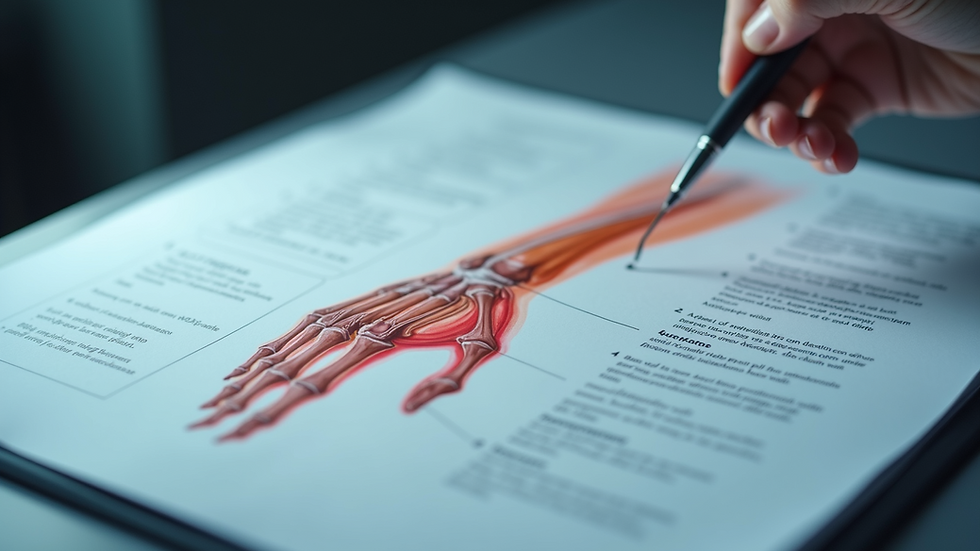Recognising Scaphoid Injury Signs
- Digital Fellows
- Jul 16
- 4 min read
A scaphoid fracture is one of the most common wrist injuries among active individuals and athletes. This type of injury often goes unnoticed initially, leading to prolonged pain and complications if left untreated. Understanding the symptoms is crucial for early diagnosis and effective treatment. In this post, we will explore scaphoid injury signs and how to recognise them promptly.
Scaphoid Injury Signs
The scaphoid bone is located in the wrist, just below the base of the thumb. It plays a crucial role in wrist motion. Injuries to this area can occur from falls, sports accidents, or direct impacts. Recognising the signs early can save you from chronic pain, reduced mobility, and even surgery.
Common signs of a scaphoid injury include:
Pain in the wrist, particularly near the base of the thumb
Swelling and tenderness around the wrist area
Difficulty moving the wrist or thumb
Bruising may also develop, although it’s not always visible

Pay close attention to these signs, especially if you've had a recent injury. Early intervention can significantly influence recovery outcomes.
What does a fractured scaphoid feel like?
When you have a fractured scaphoid, the pain can be quite distinct. It is typically sharp and localised around the wrist. Many individuals report that this pain intensifies with certain movements, particularly when trying to grip or pinch.
Here are additional details regarding the sensation associated with a scaphoid fracture:
Initial Pain: Right after injury, the pain may be severe and sudden.
Persistent Discomfort: Pain can linger, especially with wrist movements.
Radiating Pain: Sometimes the discomfort can travel up the arm or be felt in the thumb.
It's essential to note that not everyone experiences severe pain right away. Especially in non-displaced fractures, the initial symptoms may be mild, leading to a delay in seeking help.

If you're experiencing any of these symptoms, it is crucial to consult with a healthcare professional for a proper evaluation. Early treatment is vital for preventing complications.
Other Symptoms and Indicators
Aside from the initial pain and discomfort, there are other symptoms that can indicate a scaphoid fracture:
Limited Range of Motion
Individuals may find it difficult to move their wrist. This could manifest as limited bending or stretching, particularly when attempting to use the hand for activities like writing or lifting objects.
Swelling and Bruising
While swelling is a common response to injuries, with a scaphoid fracture, it usually manifests as swelling around the wrist joint. Bruising may not be immediate; for some, it can appear days after the injury.
Variable Symptoms Based on Location of Injury
If the fracture is located at the distal end of the scaphoid (closer to the hand), you might find pain and swelling more localised. If it’s at the proximal end (closer to the forearm), the discomfort may be more generalised.
Recognition of these additional symptoms can be vital for timely diagnosis and treatment. A comprehensive evaluation by a medical professional may involve X-rays or MRI scans to confirm the presence of a fracture.

Risk Factors for Scaphoid Fractures
Youth and being physically active are key factors that contribute to the likelihood of suffering a scaphoid fracture. Other risk factors include:
Sports Participation: specific sports such as snowboarding, skateboarding, or contact sports increase risk due to the likelihood of falls or direct impacts.
High Impact Activities: Activities that involve jumping, sprinting, or hard falls can result in wrist injuries.
Previous Injuries: A history of wrist injuries can make someone more susceptible to future fractures.
Understanding your risk factors can help you take preventative measures, such as wearing protective gear or strengthening wrist muscles through specific exercises.
Importance of Early Diagnosis
Recognising the symptoms of a scaphoid fracture is paramount for effective management. Delay in diagnosis can lead to complications, such as non-union of the fracture, which may necessitate surgical intervention.
If you suspect a scaphoid fracture, it is advisable to:
Seek Medical Attention: Consult with a healthcare provider or an orthopedic specialist.
Avoid Movement: Minimise using the injured wrist to prevent further damage.
Invest in Imaging: A doctor may recommend imaging techniques for accurate diagnosis.
Prompt recognition of scaphoid fracture symptoms ensures a better prognosis and quicker recovery.
Scar tissue formations and chronic pain can occur if a fracture is left unhealed. Therefore, ensuring you act timely is essential to maintain your mobility and avoid long-term complications.
Final Thoughts
Injuries can happen to anyone, anywhere, and understanding the signs can make a significant difference in your recovery process. If you've recently sustained a wrist injury, keep an eye out for the symptoms discussed above.
Early intervention for scaphoid fracture symptoms can save you from more severe complications down the road. Stay informed, stay cautious, and don't hesitate to seek medical advice when needed. Your wrists are vital to daily activities, and taking care of them should be a priority.



